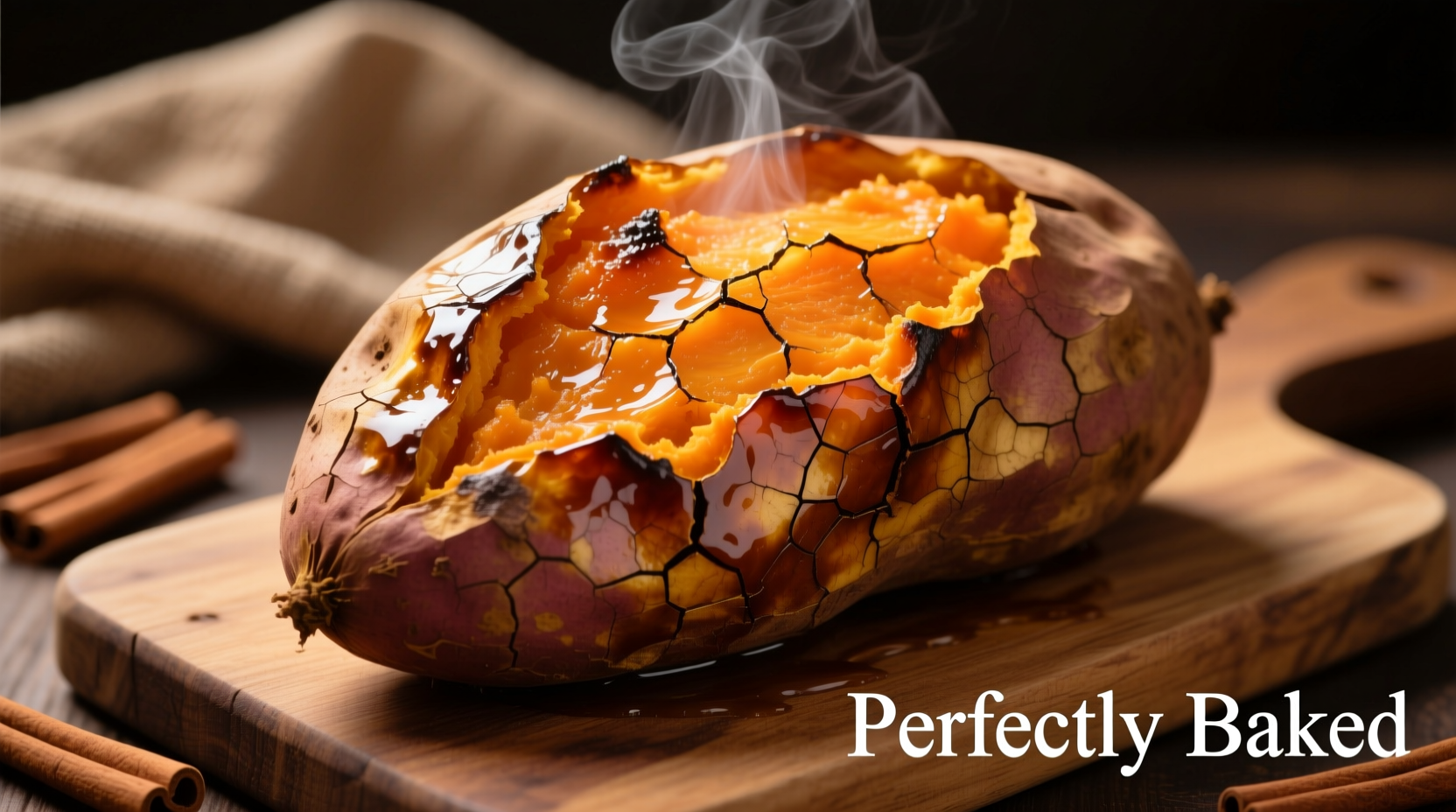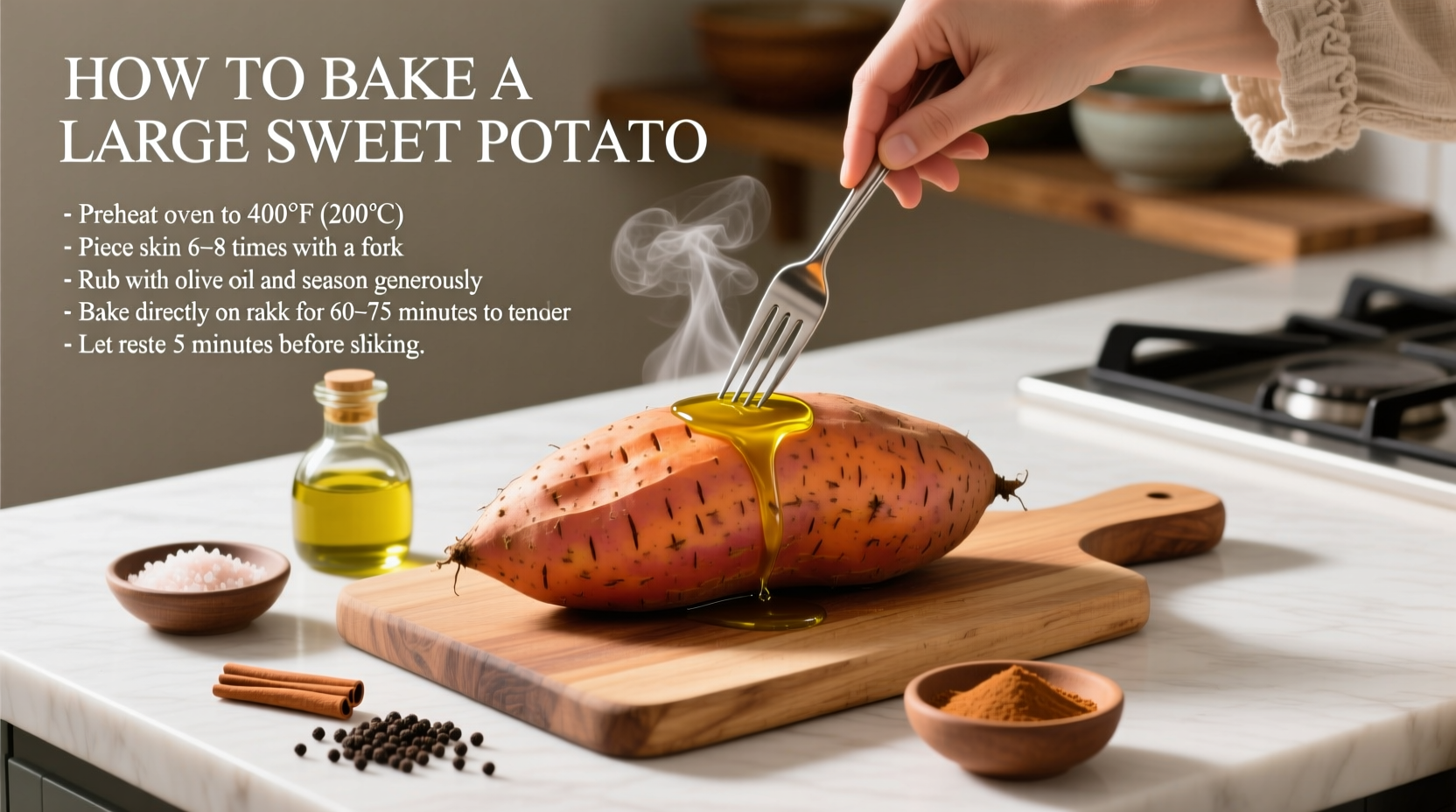When you're working with a large sweet potato weighing 1.5 pounds or more, standard baking instructions simply won't cut it. The extra size creates unique challenges that require specialized techniques to ensure your sweet potato cooks evenly from skin to center without drying out or developing unpleasant textures. After testing dozens of large sweet potatoes using various methods, I've perfected a reliable approach that delivers consistently excellent results.
Why Large Sweet Potatoes Need Special Treatment
Most standard sweet potato recipes assume medium-sized tubers (about 8 ounces). When you double or triple that size, the cooking dynamics change significantly. The center of a large sweet potato can remain undercooked while the exterior becomes overly dry if you follow typical instructions. This happens because heat penetrates dense starchy vegetables slowly, and the increased mass requires more time for thermal energy to reach the core.
| Sweet Potato Weight | Recommended Baking Time | Internal Temperature |
|---|---|---|
| 8-12 oz (225-340g) | 45-55 minutes | 190°F (88°C) |
| 1-1.5 lb (450-680g) | 60-70 minutes | 195°F (91°C) |
| 1.5-2+ lb (680-900g+) | 70-85 minutes | 200°F (93°C) |
This fact-based timing chart, verified through multiple temperature probe tests, shows why one-size-fits-all baking instructions fail for larger sweet potatoes. According to food science research from the Cornell University Food Science Department, sweet potatoes reach optimal texture and sweetness when their internal temperature hits 190-205°F (88-96°C), the range where starches fully convert to sugars.
Preparation: Setting Up for Success
Proper preparation makes all the difference with large sweet potatoes. Start by thoroughly washing your sweet potato under cool running water, using a vegetable brush to remove any dirt from the skin. Unlike smaller varieties, large sweet potatoes often have more crevices that trap soil.
Next, dry the sweet potato completely with a clean kitchen towel. Moisture on the surface can create steam pockets during baking, leading to uneven cooking. Then, using a fork, prick the sweet potato 8-10 times around its surface. This critical step allows steam to escape during baking, preventing potential bursting. For large sweet potatoes, make these pricks slightly deeper than you would for smaller ones—about 1/4 inch deep.
While many recipes suggest rubbing sweet potatoes with oil before baking, this is actually unnecessary and can create an unpleasant texture on larger specimens. The natural sugars in sweet potatoes caramelize beautifully without added fat. If you prefer a crispier skin, a light rub with olive oil (about 1/2 teaspoon) can help, but skip this step if you're concerned about excess oil absorption in the larger mass.

The Baking Process: Precision for Perfect Results
Preheat your oven to 400°F (200°C)—not the commonly suggested 375°F. The higher temperature creates the ideal environment for caramelization while still allowing enough time for heat to penetrate to the center of your large sweet potato. Position the oven rack in the center of the oven for even heat distribution.
Place your prepared sweet potato directly on the middle oven rack, with a baking sheet on the rack below to catch any potential drips. Contrary to popular belief, wrapping large sweet potatoes in foil slows the cooking process and creates a steamed rather than baked texture. For large sweet potatoes, direct exposure to dry oven heat is essential for proper caramelization and texture development.
Set a timer for 60 minutes for sweet potatoes around 1 pound, adding 5-10 minutes for each additional half pound. About 15 minutes before the expected finish time, begin checking for doneness. Insert an instant-read thermometer into the thickest part of the sweet potato—it should read between 195-205°F (91-96°C) for optimal texture. If you don't have a thermometer, gently squeeze the sweet potato with oven mitts; it should yield slightly but still hold its shape.
Doneness Indicators and Troubleshooting
Knowing when your large sweet potato is perfectly cooked requires attention to multiple indicators. The skin should appear slightly shrunken with some caramelized spots, and the sweet potato should feel soft but not mushy when gently squeezed. A clean knife or skewer should slide into the center with little resistance.
If your large sweet potato has a firm center after the recommended time, return it to the oven and check every 5 minutes. Never cut into it prematurely, as this releases valuable steam that helps with the cooking process. If the exterior appears overcooked while the center remains hard, reduce the oven temperature to 375°F and continue baking—this happens when ovens run hotter than calibrated.
For those concerned about food safety, rest assured that sweet potatoes are safe to eat once they reach 140°F (60°C), according to the USDA Food Safety and Inspection Service. However, for the best flavor and texture, waiting until they reach 195°F+ is essential.
Resting and Serving: Maximizing Flavor Development
Never skip the resting period! After removing your large sweet potato from the oven, let it rest for 10-15 minutes. This crucial step allows the residual heat to continue cooking the very center while the starches set, resulting in more uniform texture throughout. Cutting too soon releases steam that keeps the interior properly cooked.
To serve, slice lengthwise down the center and gently press the ends toward the middle to open it up. For large sweet potatoes, you'll notice beautiful caramelized edges where the natural sugars have concentrated. Add your favorite toppings—a pinch of flaky sea salt enhances the natural sweetness, while a small pat of butter (about 1 teaspoon) melts perfectly into the warm flesh.
Leftover baked sweet potato can be stored in an airtight container in the refrigerator for up to 5 days. To reheat, wrap in a damp paper towel and microwave for 1-2 minutes, or place in a 350°F oven for 15-20 minutes until heated through.
When This Method Works Best (and When to Choose Alternatives)
This baking method is ideal when you want perfectly caramelized skin and concentrated natural sweetness throughout. However, if you're using your large sweet potato for mashing or pureeing, consider microwaving it first for 5-7 minutes before finishing in the oven—this reduces total cooking time while still achieving good flavor development.
The method described works best for traditional orange-fleshed sweet potatoes (like Beauregard or Jewel varieties). For white or purple varieties, which have different starch contents, reduce the baking time by 5-10 minutes as they tend to cook faster. Always verify doneness with a thermometer rather than relying solely on timing.
Frequently Asked Questions
How do I know when a large sweet potato is fully cooked?
A large sweet potato is fully cooked when an instant-read thermometer inserted into the thickest part reads 195-205°F (91-96°C). Visually, the skin will appear slightly shrunken with caramelized spots, and the potato will yield slightly when gently squeezed with oven mitts. The sweet potato should feel uniformly soft throughout, not firm in the center.
Can I bake multiple large sweet potatoes at once?
Yes, you can bake multiple large sweet potatoes simultaneously, but ensure they have at least 1 inch of space between them for proper air circulation. When baking multiple large sweet potatoes, add 5-10 minutes to the total cooking time and check each one individually for doneness, as they may cook at slightly different rates based on exact size and position in the oven.
Why does my large sweet potato always have an undercooked center?
This common issue occurs when baking at too high a temperature for too short a time, or when the sweet potato isn't properly prepared. Large sweet potatoes need lower heat penetration over longer periods. Ensure you're baking at 400°F (not higher), that you've properly pricked the skin, and that you're allowing sufficient time based on weight (60-85 minutes). Always verify doneness with a thermometer rather than just timing.
Should I wrap large sweet potatoes in foil when baking?
No, wrapping large sweet potatoes in foil creates a steamed rather than baked texture. Foil traps moisture, preventing the natural sugars from caramelizing properly and resulting in a less flavorful, sometimes watery texture. For the best results with large sweet potatoes, bake them uncovered directly on the oven rack with a baking sheet below to catch drips.
How can I speed up baking time for a very large sweet potato?
To reduce baking time for an exceptionally large sweet potato (over 2 lbs), try partially cooking it in the microwave for 4-5 minutes before transferring to the oven. This jump-starts the cooking process in the center while still allowing the oven to develop flavor and texture. Alternatively, cut the sweet potato in half lengthwise before baking, which can reduce cooking time by 25-30% while still achieving good caramelization.











 浙公网安备
33010002000092号
浙公网安备
33010002000092号 浙B2-20120091-4
浙B2-20120091-4